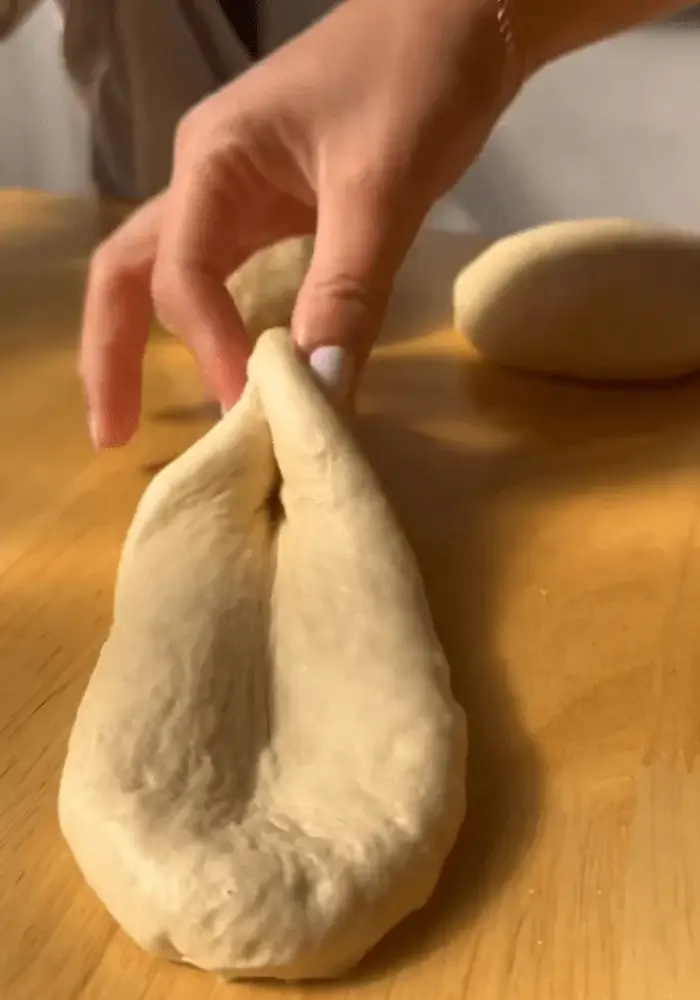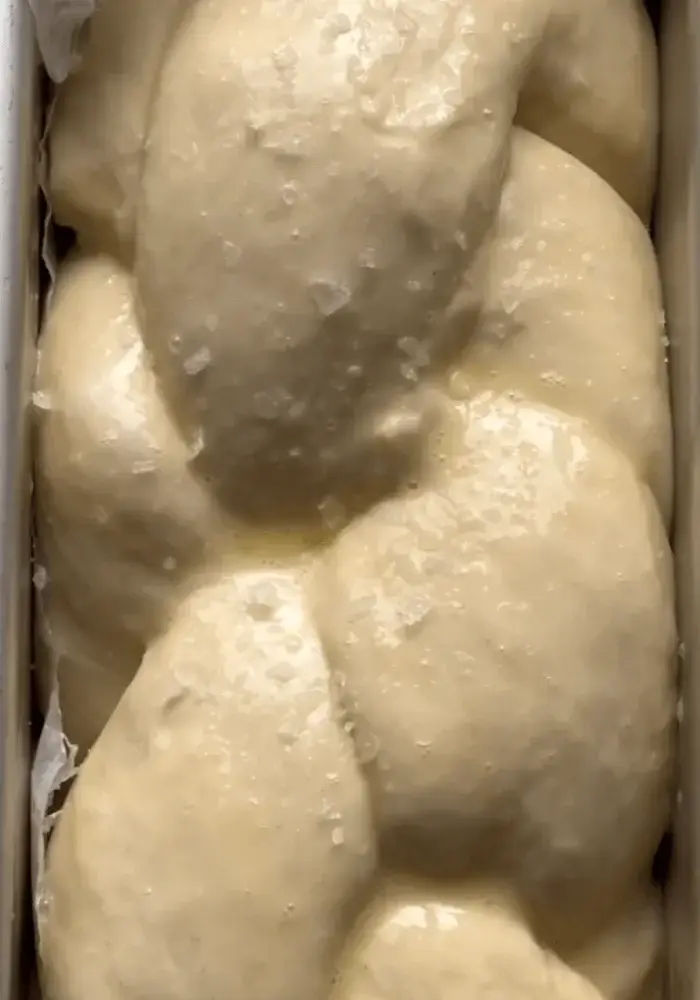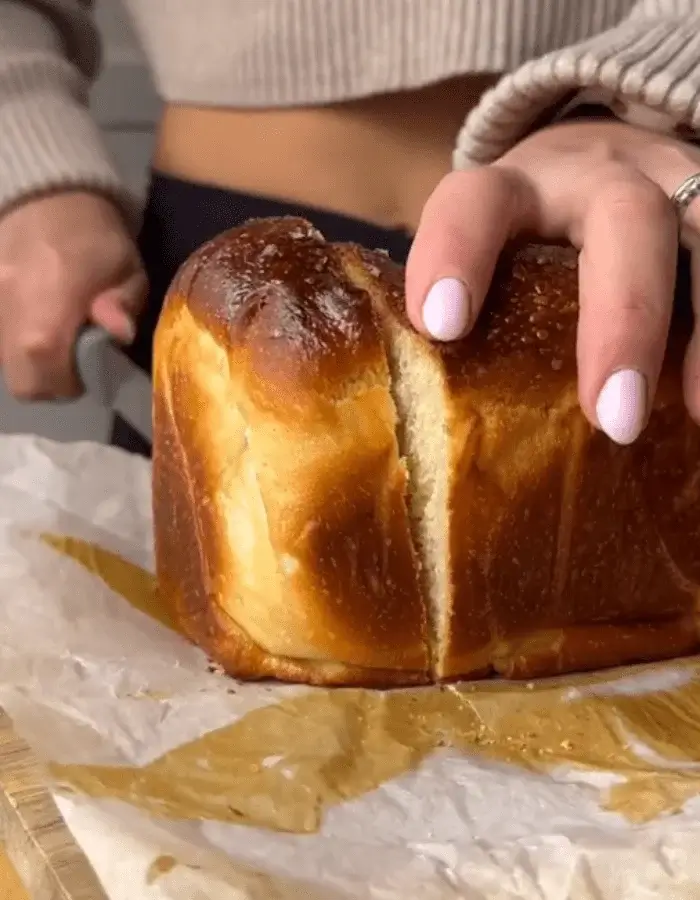Vegan Challah Loaf Bread
We may earn a commission from recommended products, at no extra cost to you. See Disclosure.
- Large bowl
- Kitchen scale
- Loaf pans (9×4-inch/23×10 cm)
INGREDIENTS
- 7¾ cups/1 kilogram all-purpose flour
- 2⅓ to 2½ cups/550 to 580 grams water
- 1 tablespoon/10 grams dry yeast
- 2 teaspoons salt
- ½ cup/100 grams sugar
- ½ cup/100 grams oil
Topping:
- 1 large egg, beaten (or: 2 tablespoons plant-based milk mixed with 1 teaspoon date syrup)
- Coarse salt
INSTRUCTIONS
- In the bowl of a stand mixer fitted with the dough hook, combine the flour, 550 grams of water, yeast, salt, sugar, and oil. Mix on low to bring the dough together, then knead on medium speed for 10 to 15 minutes, until smooth and elastic. If the dough looks stiff or dry, add up to 30 grams more water, 1 tablespoon at a time. You can also knead the dough by hand on a lightly floured surface.
- Shape the dough into a smooth ball, lightly coat with oil, and transfer to a large bowl. Cover tightly with plastic wrap and let rise in a warm place until doubled, 1 to 1½ hours. (For a deeper flavor, refrigerate the dough overnight after the first rise.)
- Turn the risen dough onto a work surface and divide into 12 to 14 portions of 160 grams each. Cover loosely with plastic wrap and let rest for 30 minutes. If the dough feels sticky, spray lightly with oil.
- Roll each piece into a medium-length rope, gently tightening the strand. Cover and let rest for another 30 minutes.
- Braid the dough as desired (a 4-strand braid is recommended) and place each loaf in a 9×4-inch/23×10 cm loaf pan. Cover loosely and let rise until puffy and jiggly when nudged, 45 to 60 minutes.
- Heat the oven to 390°F (200°C), using static heat. Brush the tops of the loaves with beaten egg and sprinkle with coarse salt. Place pans on the lowest oven rack and bake for 22 to 26 minutes, rotating if needed. Start checking at 18 minutes; the loaves should be deeply golden.
- Let the challah loaves cool in the pans for 10 minutes, then transfer to a wire rack. Slice once just warm, or let cool completely.

FAQ
Can I use whole wheat flour instead?
You can substitute up to half of the all-purpose flour with whole wheat flour in this challah loaf bread recipe without major adjustments. Using 50% whole wheat helps retain a soft texture while adding depth and a nutty flavor. If you go higher, the bread may become denser and require slightly more water. Allow for longer rising times as whole wheat flour absorbs more moisture and slows fermentation. Adding a tablespoon of vital wheat gluten per cup of whole wheat can help preserve the fluffiness that’s characteristic of good challah loaf bread.

Best way to braid challah loaf bread with four strands
Align the ropes vertically and pinch them together at the top. Number the strands from left to right (1 to 4). Move strand 1 over 2, strand 3 over 4, then strand 4 over 1. Repeat the pattern, always returning to the new order of strands before each round. This method produces a uniform braid that rises evenly in the loaf pan. For best results, use ropes of even thickness and keep slight tension in each strand so the challah loaf bread holds its shape while proofing and baking.
How should I store leftover challah loaf bread?
To keep challah loaf bread fresh, store it in an airtight plastic bag or wrapped in foil at room temperature for up to 3 days. Avoid refrigeration, as it accelerates staling. For longer storage, freeze the whole loaf or individual slices in freezer bags for up to 2 months. Thaw at room temperature or toast directly from frozen. If the crust softens after freezing, reheat in a 300°F (150°C) oven for 8 to 10 minutes. This revives the exterior texture without drying out the interior of the challah loaf bread.
Can I freeze the dough or the baked challah?
Challah loaf bread dough can be frozen after its first rise. Shape the dough, place it on a tray to freeze until firm, then transfer to an airtight bag. Thaw overnight in the refrigerator, let it come to room temperature, then allow it to proof before baking. Baked challah loaf bread also freezes well. Wrap tightly in plastic and then foil to prevent freezer burn. Thaw at room temperature or reheat in a low oven to restore its crust.

When is the challah loaf bread fully proofed before baking?
You’ll know your challah loaf bread is fully proofed when it looks puffy and jiggles slightly when the pan is gently shaken. Press a finger lightly into the dough—if the indentation springs back slowly and partially, it’s ready. If it springs back immediately, it needs more time. If it collapses, it may be over-proofed. Underproofed loaves tend to split or bake unevenly, while overproofed loaves can deflate.
Why is weighing the water in grams recommended in this recipe?
Weighing water in grams ensures precision and consistency, especially in recipes like challah loaf bread where hydration levels affect structure and rise. Measuring by volume (cups) can vary depending on temperature, altitude, and measuring tools. A scale eliminates guesswork and provides accuracy, especially important for large-batch doughs. In this recipe, small differences in water can change the dough texture significantly—too little makes it stiff, too much makes it sticky and hard to shape.

